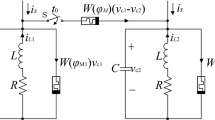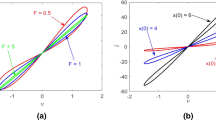Abstract
This paper presents an improved dual-memristor-based FitzHugh–Nagumo (DM-FHN) system, which is a non-autonomous circuit derived from FitzHugh–Nagumo (FHN) neuron circuit by substituting the tunnel diode with hyperbolic tangent memductance and connecting an active charge-controlled memristor in series with an inductor. The analysis model of the system is established first, and the rich dynamic behaviors of the system, varying with the circuit component parameters, are studied via the phase diagram, bifurcation diagram and Lyapunov exponential spectrum. Some interesting phenomena, such as bifurcation, periodic-chaotic state transition, periodic-chaotic bubbles, multistability phenomenon, and symmetrical behaviors, are observed. The finite-time synchronization of two coupled DM-FHN neurons for different behaviors due to different initial conditions is also studied. The cubic flux-controlled memristor is used as a synapse between the coupling circuits. The sufficient synchronization conditions for the unidirectional and bidirectional coupling DM-FHN circuits are derived respectively and the influence of the system initial values on the coupling synchronization is also investigated. The rich synchronous dynamics of the coupled DM-FHN systems are illustrated by the numerical simulations, the result of which also validates the presented analysis model.










Similar content being viewed by others
Data Availability Statement
My manuscript has associated data in a data repository.
References
L.O. Chua, Int. J. Remote Sens. 18, 507–519 (1971)
D.B. Strukov, G.S. Snider, D.R. Stewart et al., Nature 453, 80–83 (2008)
K. Viktoria, K. Vassilia, Int. J. Remote Sens. 41, 4102–4135 (2020)
S. Kumar, J.P. Strachan, R.S. Williams, Nature 548, 318–321 (2017)
Z.R. Wang, S. Joshi, S.E. Savel’ev, Nat. Mater. 16, 101–108 (2017)
C.H. Wang, H.R. Lin, J.G. Sun et al., J. Electron. Inf. Technol. 42, 795–810 (2020)
Y.G. Yu, M. Shi, H.Y. Kang et al., Nonlinear Dyn. 100, 891–906 (2020)
H.B. Bao, J.H. Park, J.D. Cao, IEEE Trans. Neural Netw. Learn. Syst. 27, 190–201 (2016)
R. Fitzhugh, Biophys. J. 1, 445–466 (1961)
J. Nagumo, S. Arimoto, S. Yoshizawa, Proc. Ire. 50, 2061–2070 (1962)
J.H. Zhang, X.F. Liao, A.E.Ü. Int, J. Electron. Commun. 75, 82–90 (2017)
J.H. Zhang, X.F. Liao, Nonlinear Dyn. 95, 1269–1282 (2019)
H. Bao, W.B. Liu, M. Chen, Nonlinear Dyn. 96, 1879–1894 (2019)
M. Chen, J.W. Qi, Q. Xu et al., AEÜ Int. J. Electron. Commun. 201940, 152840 (2019)
M. Chen, J.W. Qi, H.G. Wu et al., Sci. China Technol. Sci. 63, 1035–1044 (2020)
W. Yan, C.H. Wang, Y.H. Sun et al., Neurocomputing 404, 367–380 (2020)
A.L. Shanmugam, P. Mani, R. Rajan et al., IEEE Trans. Cybern. 50, 911–922 (2020)
W.P. Wang, J. Xiao, X. Luo et al., Chaos Soliton Fract. 126, 85–96 (2019)
X.Y. Wang, G. Suo, Inf. Sci. 507, 16–36 (2020)
Q. Lai, B. Norouzi, F. Liu, Chaos Soliton Fract. 114, 230–245 (2018)
Q. Lai, Z.Q. Wan, P.D.K. Kuate et al., Commun. Nonlinear Sci. 89, 105341 (2020)
F.H. Min, H.Y. Ma, Y.M. Lv, Eur. Phys. J-Spec. Top. 228, 1493–1514 (2019)
M. Kountchou, P. Louodop, S. Bowong et al., Int. J. Bifurcat. Chaos. 26, 1–18 (2016)
C.Q. Zhou, C.H. Yang, D.G. Xu et al., IEEE Access. 7, 52896–52902 (2019)
C. Zhou, C.H. Wang, Y.C. Sun et al., Neurocomputing 403, 211–223 (2020)
S. Khorashadizadeh, M.H. Majidi, Front. Inf. Tech. El. 19, 1180–1190 (2018)
V. Resmi, G. Ambika, R.E. Amritkar, Phys. Rev. E 84, 046212 (2011)
B. Zhen, Z.H. Li, Z.G. Song, Appl. Sci.-Basel 9, 2159 (2019)
M. Iqbal, M. Rehan, K.S. Hong, Front. Neurorob. 12, 6 (2018)
H.D. Li, X.L. Yang, Z.K. Sun, Nonlinear Dyn. 93, 1301–1314 (2018)
C.G. Yang, S. Adhikari, H. Kim, Sci. China Inf. Sci. 61, 060427 (2018)
S.K. Thottil, R.P. Ignatius, Nonlinear Dyn. 87, 1–21 (2016)
K. Usha, P.A. Subha, Chin. Phys. B 28, 020502 (2019)
B.C. Bao, Q.F. Yang, D. Zhu et al., Nonlinear Dyn. 99, 2339–2354 (2020)
H. Bao, Y.Z. Zhang, W.B. Liu et al., Nonlinear Dyn. 100, 937–950 (2020)
S. Vaidyanathan, C.K. Volos et al., J. Eng. Technol. Rev. 8, 157–173 (2015)
K. Murali, M. Lakshmanan, L.O. Chua, Int. J. Bifurcat. Chaos. 5, 563–71 (1995)
G.Y. Peng, F.H. Min, Nonlinear Dyn. 90, 1607–1625 (2017)
A.I. Ahamed, M. Lakshmanan, Int. J. Bifurcat. Chaos. 23, 1350098 (2013)
B.C. Bao, L. Xu, N. Wang et al., AEÜ Int. J. Electron. Commun. 94, 26–35 (2018)
Acknowledgements
This work is supported by the National Nature Science Foundation of China under Grant nos. 61971228 and 61871230, the Natural Science Foundations of Jiangsu Higher Education Institutions of China under Grant no. 19KJB520042, and the Postgraduate Research and Practice Innovation Program of Jiangsu of China under Grant No. KYCX20_1247.
Author information
Authors and Affiliations
Contributions
YW and FM equally contributed to this work. YW carried out numerical simulations of synchronization and wrote the draft. FM developed theoretical approaches and revised the draft. YC and YD participated in discussing the contents.
Corresponding author
Ethics declarations
Conflict of interest
The authors declare no conflict of interest.
Rights and permissions
About this article
Cite this article
Wang, Y., Min, F., Cheng, Y. et al. Dynamical analysis in dual-memristor-based FitzHugh–Nagumo circuit and its coupling finite-time synchronization. Eur. Phys. J. Spec. Top. 230, 1751–1762 (2021). https://doi.org/10.1140/epjs/s11734-021-00121-0
Received:
Accepted:
Published:
Issue Date:
DOI: https://doi.org/10.1140/epjs/s11734-021-00121-0




